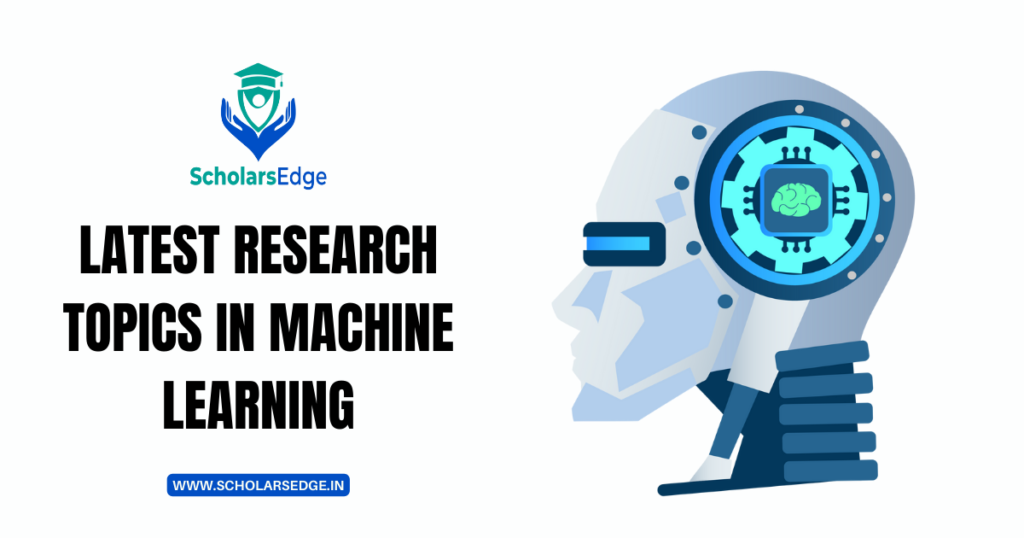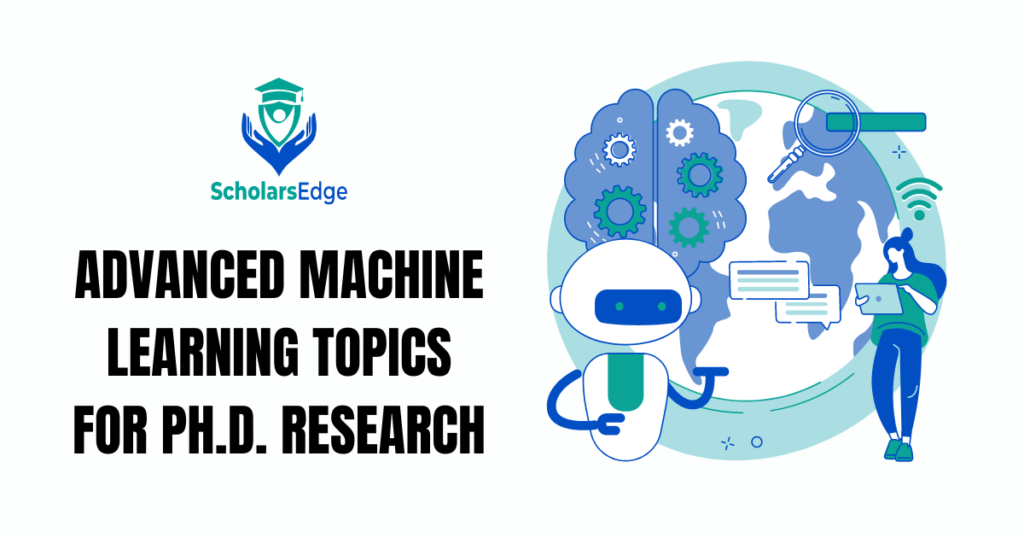
Machine learning (ML) has become a cornerstone of modern technology, driving advancements in various fields, from healthcare to finance. Its ability to analyze vast amounts of data and generate predictive models has revolutionized the way problems are solved. Staying updated with the latest research trends in machine learning is essential for Ph.D. research scholars, professors, and researchers to contribute meaningfully to this rapidly evolving field. This blog explores foundational and advanced research topics in machine learning, highlighting current trends and specialized areas of research.
30 Latest Research In Machine Learning
| No. | Topic and Description |
|---|---|
| 1 | Supervised Learning: Techniques, advancements, and applications in labelled data learning. Supervised learning models are essential for tasks ranging from image recognition to disease prediction, where the model is trained on a labelled dataset to make accurate predictions. |
| 2 | Unsupervised Learning: Key methodologies and use cases for pattern recognition in unlabeled data. This involves clustering, association, and dimensionality reduction techniques to uncover hidden patterns without predefined labels. |
| 3 | Reinforcement Learning: Developing algorithms for optimal behavior through environmental interaction. RL is used in robotics, gaming, and automated control systems, where an agent learns to achieve goals by taking actions in an environment. |
| 4 | Generative Adversarial Networks (GANs): Recent breakthroughs and applications in generating realistic data. GANs are used for creating high-quality images, videos, and even synthetic data for research and commercial purposes. |
| 5 | Transfer Learning: Innovations in applying pre-trained models to new tasks. Transfer learning reduces the need for large datasets and computational resources by leveraging knowledge from existing models. |
| 6 | Meta-Learning: Understanding models that can learn to learn and adapt quickly to new tasks. This approach is useful in scenarios where quick adaptation to new data is required, such as personalized recommendations and few-shot learning. |
| 7 | Federated Learning involves training models collaboratively with decentralized data, focusing on privacy preservation. This technique allows data to remain on local devices while still contributing to a global model, enhancing data privacy and security. |
| 8 | Explainable AI (XAI): Enhancements in making AI models transparent and interpretable. XAI is critical for building trust in AI systems by providing insights into how decisions are made, which is especially important in sensitive applications like healthcare and finance. |
| 9 | Quantum Machine Learning: Exploring the intersection of quantum computing and ML for enhanced capabilities. Quantum ML aims to leverage quantum algorithms to solve complex problems more efficiently than classical methods. |
| 10 | Neuroscience and Machine Learning: Applying ML techniques to understand brain functions and develop brain-computer interfaces. This research includes modelling neural activity and predicting neurological disorders. |
| 11 | AI in Healthcare: Latest techniques in medical diagnosis, treatment, and patient care through ML. Applications include predictive analytics, medical imaging, and personalized medicine, improving healthcare outcomes. |
| 12 | Natural Language Processing (NLP): New approaches in language understanding, generation, and translation. NLP advancements are powering chatbots, translation services, and sentiment analysis tools. |
| 13 | AutoML: Automating the machine learning pipeline for model selection and optimisation. AutoML tools help non-experts build effective models by automating tedious and complex tasks in the ML workflow. |
| 14 | Adversarial Machine Learning: Improving model robustness against adversarial attacks. Research in this area focuses on making ML models resistant to inputs designed to deceive them, ensuring reliability and security. |
| 15 | Causal Inference in Machine Learning: Understanding cause-and-effect relationships in data. This is crucial for making decisions based on data-driven insights, especially in fields like healthcare and economics. |
| 16 | Classical Image Processing Techniques: Current advancements in non-ML based image processing methods. Techniques include edge detection, segmentation, and morphological operations. |
| 17 | Edge Detection and Segmentation are techniques for identifying boundaries and partitioning images into meaningful regions. These methods are fundamental for tasks such as object recognition and medical image analysis. |
| 18 | Image Enhancement and Restoration: Methods to improve and restore image quality. Research includes techniques to reduce noise, enhance contrast, and recover lost details in images. |
| 19 | Ethics in AI: Addressing bias, fairness, and ethical implications in AI development and deployment. This includes creating frameworks to ensure AI systems are used responsibly and transparently. |
| 20 | Sustainability and AI: Using ML to tackle environmental challenges and promote sustainable practices. Applications include resource optimisation, climate change prediction, and energy management. |
| 21 | Human-AI Interaction: Enhancing collaboration and communication between humans and AI systems. Research focuses on developing intuitive interfaces and adaptive systems that improve user experience. |
| 22 | Machine Learning in Cybersecurity: Detecting and responding to security threats using ML techniques. ML is employed to identify anomalies, predict potential threats, and automate responses in cybersecurity. |
| 23 | AI in Financial Market Prediction: Applying ML for market trend analysis and prediction. Techniques include time series analysis, sentiment analysis, and portfolio management optimisation. |
| 24 | Machine Learning for Real-Time Traffic Prediction: Developing models for predicting and managing traffic in real-time. These models help in optimising traffic flow and reducing congestion. |
| 25 | AI in Autonomous Vehicles: Techniques for self-driving car technologies, including perception, planning, and control. Research focuses on improving the safety and efficiency of autonomous navigation. |
| 26 | AI in Robotics: Developing intelligent robotic systems for various applications. This includes robots for manufacturing, healthcare, and service industries. |
| 27 | AI in Education: Creating personalised learning experiences and intelligent tutoring systems. ML is used to adapt educational content to individual student needs, enhancing learning outcomes. |
| 28 | AI in Creative Industries: Generating art, music, literature, and other creative content using ML. This includes applications in content creation, design, and entertainment. |
| 29 | AI for Wildlife Conservation: Monitoring habitats and species using AI-driven techniques. Applications include tracking animal movements, identifying species from images, and predicting poaching activities. |
| 30 | AI in Smart Cities: Improving urban planning and infrastructure management through AI. Research includes traffic management, energy usage optimisation, and enhancing public services. |
Foundational Machine Learning Research Topics
Supervised Learning
Supervised learning involves training models on labelled data to make predictions or classify data points. Recent advancements focus on improving accuracy and efficiency through techniques like deep neural networks, support vector machines, and ensemble methods. Applications range from spam detection to medical diagnosis, showcasing its versatility and impact.
Unsupervised Learning
Unsupervised learning aims to identify patterns and relationships in unlabelled data. Key methodologies include clustering algorithms like k-means and hierarchical clustering, and dimensionality reduction techniques like principal component analysis (PCA). These methods are crucial for exploratory data analysis and feature extraction, providing insights without prior labels.
Reinforcement Learning
Reinforcement learning (RL) enables agents to learn optimal behaviours through interaction with their environment, receiving rewards or penalties based on their actions. Latest developments in RL, such as deep reinforcement learning, have been applied in areas like robotics, game playing (e.g., AlphaGo), and autonomous driving, pushing the boundaries of what machines can achieve through trial and error.
Advanced Machine Learning Topics for Ph.D. Research

Generative Adversarial Networks (GANs)
GANs have revolutionized the field of generative models, enabling the creation of realistic images, videos, and even music. Recent research focuses on improving the stability and quality of GAN outputs, exploring applications in art, data augmentation, and synthetic data generation.
Transfer Learning
Transfer learning leverages pre-trained models on large datasets to improve performance on related tasks with smaller datasets. Innovations in this area are shaping modern ML by reducing the need for extensive data and computational resources, making it accessible for a wide range of applications.
Meta-Learning
Meta-learning, or “learning to learn,” involves developing models that can adapt quickly to new tasks with minimal data. This approach is gaining traction in scenarios where training data is scarce, enhancing the generalization capabilities of ML models.
Latest Machine Learning Research Trends
Federated Learning
Federated learning allows training ML models across multiple decentralized devices or servers holding local data samples without exchanging them. This approach addresses privacy concerns and is particularly relevant in healthcare and finance, where data sensitivity is paramount.
Explainable AI (XAI)
XAI focuses on making ML models transparent and interpretable. Enhancements in this field aim to build trust and facilitate the adoption of AI systems by providing clear, understandable explanations of model decisions, crucial for applications in healthcare and finance.
Quantum Machine Learning
Quantum machine learning explores how quantum computing can enhance and accelerate ML algorithms. This emerging field promises significant computational advantages, potentially transforming areas like cryptography, optimization, and complex simulations.
Specialized Machine Learning Research Areas
Neuroscience and Machine Learning
The intersection of neuroscience and ML is leading to breakthroughs in understanding brain functions and developing brain-computer interfaces. Research includes modelling neural activity and predicting neurological conditions, fostering advancements in both AI and neuroscience.
AI in Healthcare
Machine learning is revolutionizing healthcare, with applications in disease diagnosis, drug discovery, and personalized treatment. The latest techniques include predictive analytics, medical imaging analysis, and wearable technology data integration, which improve patient outcomes and operational efficiency.
Natural Language Processing (NLP)
NLP involves the interaction between computers and human language. New approaches in NLP focus on language understanding, generation, and translation, with models like GPT-4 pushing the envelope in creating human-like text and dialogue systems.
Machine Learning Topics for Presentations and Thesis
AutoML
Automated Machine Learning (AutoML) simplifies the process of applying ML by automating model selection, hyperparameter tuning, and feature engineering. This field aims to democratise ML, making it accessible to non-experts and reducing the time and effort required to build effective models.
Adversarial Machine Learning
Adversarial ML studies how to make models robust against adversarial attacks designed to fool them. This area is critical for security applications, ensuring the reliability and trustworthiness of AI systems in sensitive environments.
Causal Inference in Machine Learning
Causal inference focuses on understanding cause-and-effect relationships in data, going beyond mere correlations. This research area is vital for making informed decisions in fields like healthcare, economics, and social sciences.
Image Processing without Machine Learning
Classical Image Processing Techniques
Classical image processing involves techniques that do not rely on ML, such as edge detection, segmentation, and morphological operations. Current research in this area focuses on improving these techniques for applications in medical imaging, remote sensing, and industrial inspection.
Edge Detection and Segmentation
Edge detection identifies boundaries within images, while segmentation partitions images into meaningful regions. These techniques are fundamental for tasks like object recognition and scene understanding, with ongoing research enhancing their accuracy and efficiency.
Image Enhancement and Restoration
Image enhancement improves the visual quality of images, and restoration corrects distortions and noise. Recent advancements in these techniques are critical for applications in photography, satellite imagery, and medical diagnostics.
Current and Future Directions in Machine Learning
Ethics in AI
Ethical considerations in AI address issues like bias, fairness, and accountability. Research focuses on developing frameworks and guidelines to ensure that AI systems are designed and deployed responsibly, fostering public trust and adoption.
Sustainability and AI
Applying ML to address environmental challenges is an emerging field. Research includes optimizing resource management, predicting climate change impacts, and promoting sustainable practices through intelligent systems.
Human-AI Interaction
Improving the ways humans interact with AI systems is crucial for enhancing collaboration and effectiveness. Research in this area explores intuitive interfaces, natural language communication, and adaptive learning systems that personalize user experiences.
Conclusion
Machine learning continues to evolve, offering new opportunities and challenges for researchers and practitioners. This blog has highlighted foundational and advanced research topics, current trends, and specialized areas in ML, providing a comprehensive overview for those looking to stay at the forefront of this dynamic field. By delving deeper into these areas, researchers can contribute to the advancement of machine learning, driving innovation and addressing critical societal challenges.
FAQs on Research Topics in Machine Learning
How to choose a topic for research in machine learning?
Choosing a compelling research topic in machine learning requires careful consideration. Start by identifying areas that excite you and have room for novel contributions, then conduct a thorough literature review to understand the state-of-the-art and identify gaps or limitations in prior work. Clearly define your research problem, highlighting its importance, the challenges involved, and a high-level sketch of potential solutions. Consult with mentors and advisors to get their input on promising directions. The key is to find a topic that is novel, relevant to the research community, and aligns with your interests – this will set you up for successful and impactful machine learning research.
How can I identify gaps in current machine learning research?
Identifying gaps in current machine learning research requires a combination of thorough literature review, expert consultation, analysis of existing data and techniques, and an eye for emerging trends and real-world problems. Carefully examine recent papers, conference proceedings, and survey articles to understand the state-of-the-art and limitations while also considering input from advisors and experts in the field. Look for opportunities to apply new models, leverage larger datasets, tackle underexplored problems, or address societal challenges that current ML approaches fall short of. By clearly defining the research gap you aim to address, its importance, and your proposed approach, you can ensure your work is focused and impactful in making meaningful contributions to the field of machine learning.
What are some good machine learning research topics for a thesis?
Some promising machine learning research topics for a thesis include exploring novel deep learning architectures for tasks like text classification, image recognition, or time series forecasting; developing incremental or meta-learning approaches to improve model generalization; applying machine learning to real-world challenges like depression detection from social media data, network intrusion analysis, or financial product recommendations; and investigating techniques to improve the interpretability and robustness of machine learning models. The key is to identify a research gap, propose a novel solution that addresses the limitations of prior work, and demonstrate the practical impact of your approach.
